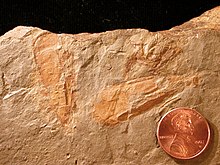Hyolithid
| Hyolitha Temporal range: Fortunian to end Permian, 536–252.2 Ma |
|
|---|---|
 |
|
| Hyolithes cerops, Spence Shale, Idaho (Middle Cambrian) | |
| Scientific classification | |
| Kingdom: | Animalia |
| Superphylum: | Lophotrochozoa |
| Class: |
†Hyolitha Marek, 1963 |
| Orders | |
Hyoliths are animals with small conical shells, known as fossils from the Palaeozoic Era. They are lophophorates, a group which includes the brachiopods.
The shell is typically one to four centimeters in length, triangular or elliptical in cross section. Some species have rings or stripes. It comprises two parts: the main conical shell (previously referred to as a ‘conch’) and a cap-like operculum. Some also had two curved supports known as helens They are calcareous – probably aragonitic All of these structures grew by marginal accretion.
The orthothecid shell has an internal layer with a microstructure of transverse bundles, and an external layer comprising longitudinal bundles.
Some hyoliths had helens, long structures that taper as they coil gently in a logarithmic spiral in a ventral direction. The helens had an organic-rich central core surrounded by concentric laminae of calcite. They grew by the addition of new material at their base, on the cavity side, leaving growth lines.
They were originally described by Walcott as separate fossils under the genus name Helenia, (Walcott's wife was named Helena and his daughter Helen); Bruce Runnegar adopted the name helen when they were recognized as part of the hyolith organism. Encrusting organisms have been found on helens, and also on both sides of the main shell, all of which are therefore supposed to have been raised above the sea bed. The helens have been interpreted as props that supported the feeding organ, the lophophore, above the sea bed.
The operculum closes over the aperture of the shell, leaving two gaps through which the helens can protrude. It comprises two parts: the cardinal shield, a flat region at the top of the shell; and the conical shield, the bottom part, which is more conical. The inside of the shell bears a number of protrusions, notably the dorsal cardinal processes and the radially-arranged clavicles.
The soft tissues of the mid-Cambrian hyolith Haplophrentis, from the Burgess Shale and Spence Shale Lagerstätten include a gullwing-shaped band below the operculum. This band is interpreted as a lophophore, a feeding organ with a central mouth; it bears 12 to 16 tentacles. From the mouth a muscular pharynx leads to a gut, which loops back and exits beyond the crown of tentacles. Next the gut are a pair of large kidney-shaped organs of uncertain nature. Under the operculum are muscles. The thin body wall circumscribes the interior of the shell, except the apex.
...
Wikipedia
